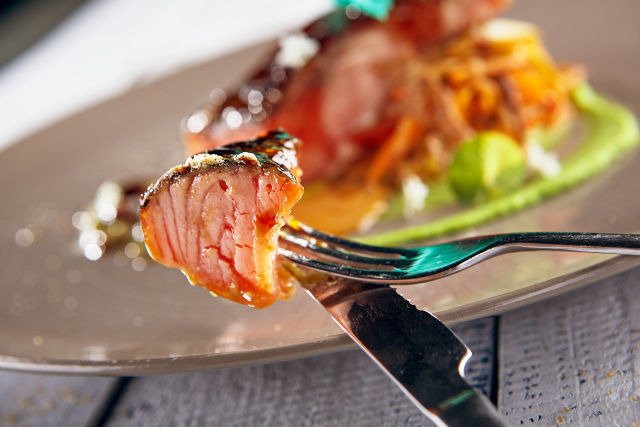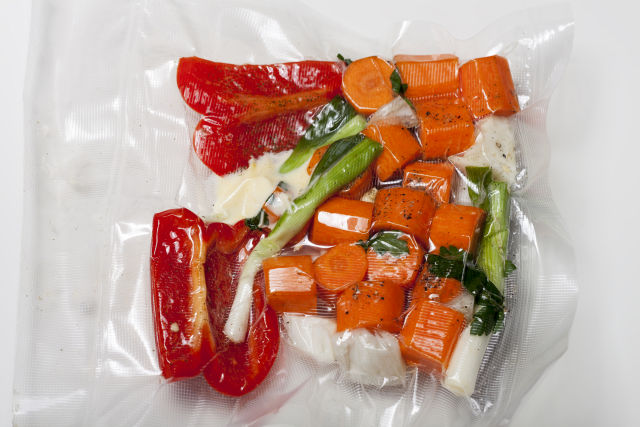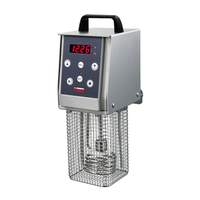Sous vide cooking takes the guesswork out of fine dining. That saves labor and food costs in a high-end environment where there’s no room for error - not even a few degrees, or a couple of minutes.
Because when you serve a $45 steak, the last thing a foodservice operator wants is a ribeye returned to the kitchen and a negative Yelp review.
What is sous vide? Envision consistency and efficiency.
Sous vide cooking prepares meats and vegetables in a vacuum-sealed plastic pouch or glass jar for a water bath or steam. The item is then cooked for longer than usual times at an extremely regulated temperature, much lower and slower than normal cooking.
The goal is perfect, even-cooked items, from edge to edge, and retention of moisture and volume.
How does sous vide cooking improve fine dining? These establishments cannot afford to let their finished products differ. Perfection with every cover is the goal.
Consistency & Efficiency. That's sous vide cooking.
"We all know labor retention is one of the biggest challenges facing the restaurant industry. Sous vide cooking can help", said Bernard "Bernie" McDonough, an ACityDiscount sales rep who has worked as a chef for 27 years.
"Cooks flow in and out of kitchens. A guy might stick around for six, eight months then leave, so training is a big deal," McDonough said.
President/CEO John Stack created this amazing sous vide dish for ACityDiscount's annual Christmas dinner.And the next order up is an airline chicken breast. Ready or not, here comes an order! Is your new line cook ready for the dinner rush?
"To properly cook it," McDonough continued about the airline chicken breast, "you're looking at about 22-24 minutes to get it perfect. Cook it for 25 minutes, and it’s going to start drying out. Cook it for 21 minutes, and the customer is going to see pink and send it back to the kitchen. It has to be perfect."
Perfection is challenging enough for veterans in the kitchen. And now, a newbie is pressed into duty. Enter sous vide.
Sous Vide: under vacuum (French translation)
With sous vide cooking, a fine dining establishment or caterer can cook the same chicken breast 75-80 percent of the way then leave it to the staff (hours later) to finish it when ordered: bring it up to temperature, sear it and in minutes ... Bon Appétit! Now that’s consistency and efficiency.
- Beef Tenderloin, Sirloin, Ribeye, T-Bone Steaks 134°F | 1 – 4 hrs
- Baby Back Ribs 165°F | 4-12 hrs
- Beef Spare Ribs 176°F | 34-72 hrs
- Flank Steak, Brisket 134°F or Higher | 8 – 30 hrs
- Pork Tenderloin 134°F or Higher | 90 mins – 8 hrs
- Pork Chops 134°F or Higher | 4-10 hrs
- Chicken Breast (Bone-In) 146°F or Higher | 2.5 – 6 hrs
- Chicken Breast (Boneless) 146°F or Higher | 1 – 4 hrs
- Shrimp (Large) 140°F | 30 mins
- Lean Fish – Desired Serving Temp Desired Serving Temp | 30 – 40 mins
- Beets, Carrots, Celery Parsnips, Potatoes, Turnips 183°F | 1 – 4 hrs
- Asparagus, Broccoli, Cauliflower, Corn, Eggplant, etc. 183°F | 45 mins – 1.5 hrs
- Apples, Pears 183°F | 45 mins – 2 hrs
- Peaches, Apricots, Plums, Mango, Nectarines, Strawberries 183°F | 30 – 60 mins
- SOURCE: VACMASTER
What You Need To Get Started with Sous Vide:
- Immersion Circulator (Sous Vide Cooking method)
- Heavy Duty Bags (To Hold Food Item)
- Vacuum Packing Machine
- A Pot or Container (To Hold Water)
- Clips (Optional)
More Reasons to Love Sous Vide Cooking: Lack of Shrinkage
"When you’re braising a dish, you cook it for a longer period of time. Moisture, juices, fats are all going to seep out," McDonough said. "With Sous Vide Cooking, the item is vacuumed under pressure. It has nowhere to go. So you're going to have a higher yield."

According to thespruce.com, "a steak cooked in a skillet to the proper internal temperature for medium rare (125°F - 128°F) results in a dry exterior meat and nearly four percent decrease in weight." The same steak cooked sous vide style will retain its weight, as well as internal juices.
Bottom line: Bigger (and tastier) steaks increase profit margins.
It’s great for delicate items that are easy to overcook.
Think fish; for example, sea bass.
Or dishes that are easy to dry out.
How about chicken breasts (use it for pulled chicken or chicken salads).
Sous vide cooking is perfect for meats with a lot of connective tissue.
Brisket, oxtails and pot roast are great examples.
How about eggs?
Sure, you can do it the old-fashioned, faster way. But with the exception of a fried egg, every other type of egg can be created through sous vide cooking, from poached to scrambled (yes, scrambled).

Don't forget about vegetables.
Carrots, eggplant and asparagus are sous vide favorites.
Some sous vide experts have experimented with desserts.
Crème brulee, anyone?
Sear before or after sous vide?
It depends on personal preference, same as the equipment to sear it in (cast iron skillet or broiler?)
Bone-in or Boneless?
Some sous vide cooking specialists steer clear of cooking meats with bones, while others find a way to prepare meats like the prime rib in the ACityDiscount video above.
It's all a matter of preference. John Stack of ACityDiscount, created a tasty prime rib for the company’s 2017 Christmas party, cooked to medium at 135°F.
Bring It On Home!
While sous vide cooking can be found in fine dining establishments throughout America, you don’t have to be a James Beard Award recipient to master this tasty style of cooking. In recent years, sous vide has become more popular for foodies at home. Marty Stack of ACityDiscount enjoys sous vide cooking because it eliminates room for error.
If you know the right temperature to cook, you don’t have to tend to it closely," Stack said. "I like to take the less-expensive cuts of meat (beef short ribs, tri-tip, etc.) and turn them into something amazing; instead of focusing on an expensive cut of meat that to some extent, is going to be good no matter what you do to it."Ready to learn more about sous vide cooking? Call Bernard “Bernie” McDonough at 404-752-6715.



